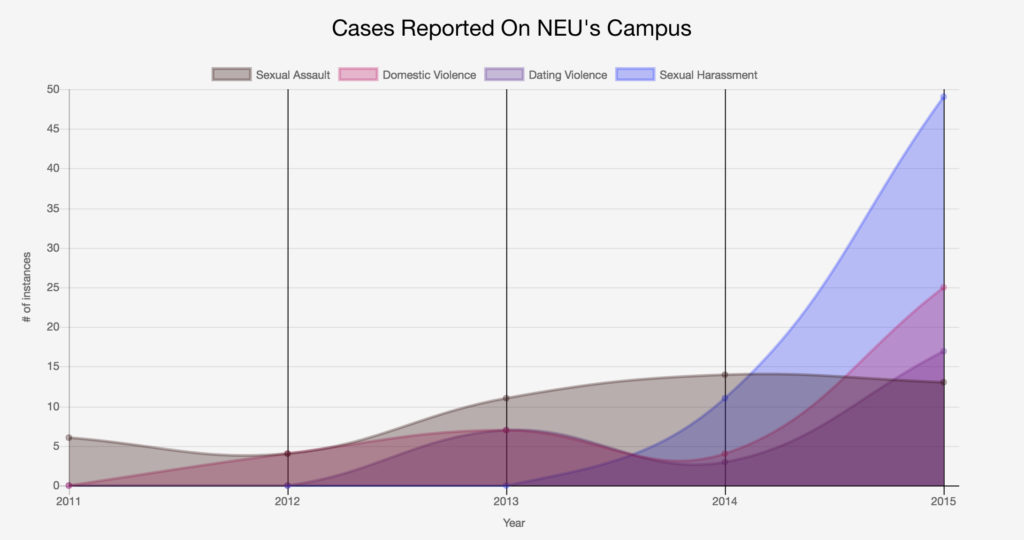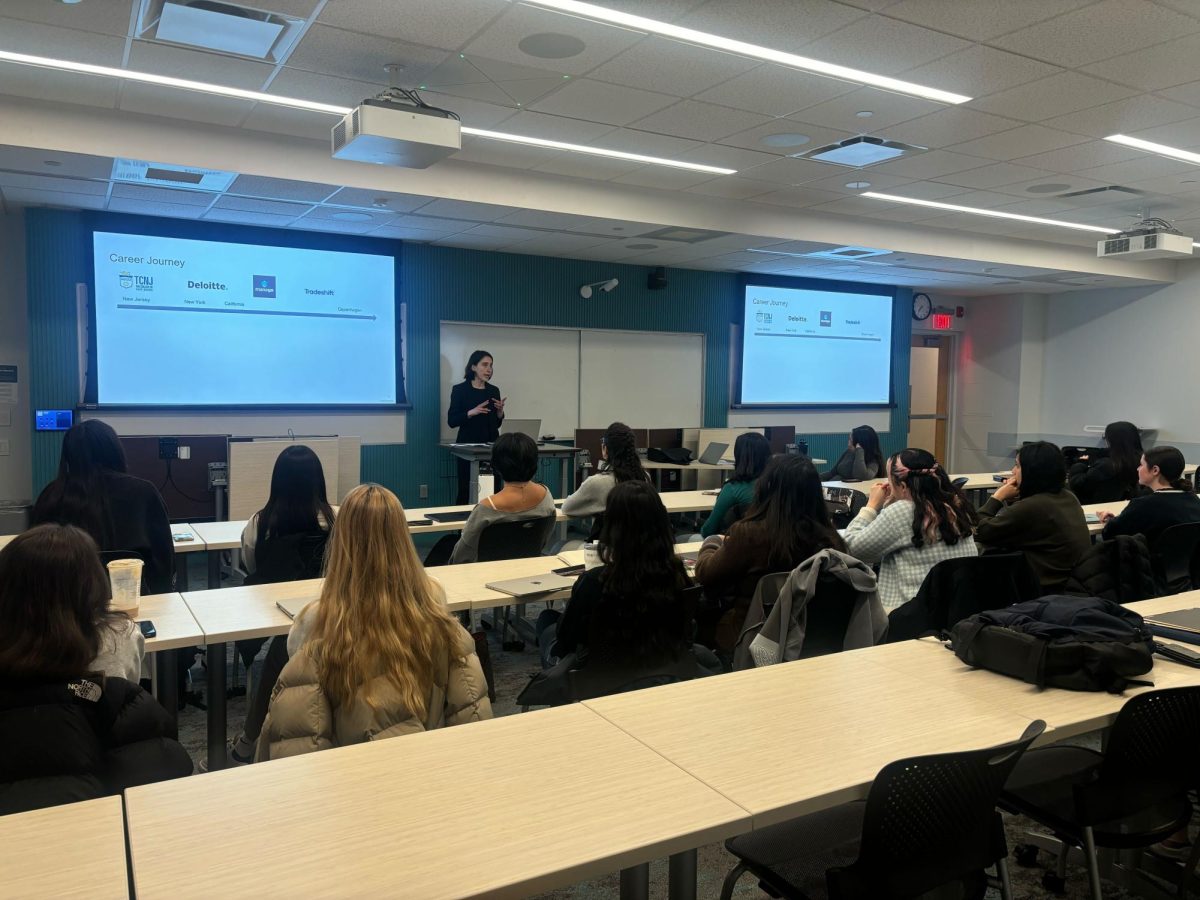By Rowan Walrath and Sam Haas, news staff
TRIGGER WARNING: This story contains material which may be upsetting or harmful to survivors of sexual violence, sexual harassment and/or hate crimes.
Domestic violence, dating violence and sexual harassment incidents reported on Northeastern’s Boston campus significantly increased last year, according to the university’s annual crime and fire safety report released late Friday afternoon.
Forty-nine reports of sexual harassment (34 of which involved graffiti or sexual drawings in residential buildings), 25 reports of domestic violence and 17 reports of dating violence were made in 2015. These numbers increased respectively from totals of 11, four and three in 2014. On-campus stalking reports also rose, from three in 2014 to seven in 2015.
Thirteen sexual assaults were reported on campus in 2015, consistent with previous years’ totals of 14 in 2014 and 11 in 2013. Sexual assault is defined in the report as a sexual act directed against another person without their consent.
Roxanne Anderson, senior human services major and president of the Sexual Assault Response Coalition (SARC) at Northeastern, had mixed reactions to the report.
“I think whenever we see increases of numbers like this, it can be kind of bittersweet,” Anderson said. “It’s hard to think that behind those numbers is an individual, an individual who suffered that experience. But I think at the same time, it shows Northeastern’s ability to advocate for the resources that are available, and it shows that the people who have been through these things feel strong enough and confident in their university enough to report these incidents.”
Northeastern University Police Department (NUPD) Chief and Director of Police Michael Davis announced the report’s publication in an email to the campus community at 4 p.m. on Friday, Sept. 30. Crime statistics contained in the document for the years 2013 to 2015, broken down by year, were compiled from reports made to NUPD and the Boston Police Department (BPD), as well as from cases recorded by other university officials including deans and residential staff.
Under the federal Jeanne Clery Act, passed in 1990, higher education institutions receiving federal funding must disseminate information about crimes committed on and around campus each year. The university was required to release this year’s safety report by Oct. 1 to comply with the law, or risk a fine of up to $35,000.
Madeleine Estabrook, vice president of student affairs at Northeastern, attributed the increase in reports of dating violence, domestic violence and sexual harassment to a focus among police and university staff to encourage students to report such incidents.
“The work that we do in raising awareness and making sure people know where their resources are is like doing community policing,” Estabrook said. “You do this with the knowledge that more people are going to report because there’s now an opportunity to report, people know where to report […] and people feel more comfortable reporting.”
Corey Rayburn Yung is a professor of law at Kansas University who released a study in 2015 claiming schools underreported cases of sexual violence and rape under the Clery Act. He said the increase in reported incidents of domestic violence, dating violence and sexual harassment could be positive.
“Generally, when it comes to gendered violence in the past couple of years, increases should be taken as a good sign,” Yung said.
First, this means the university is treating such violence as a greater issue, according to Yung; second, more people are reporting.
Like Yung, Estabrook identified underreporting of sexual violence and other Clery Act cases as a problem, one which she says the university is addressing.
“Domestic abuse and sexual violence are woefully underreported,” Estabrook said. “We anticipated and expected more reporting, and that is part of the reason for doing the awareness. The more that we engage and show what the resources are, when somebody reports, [we can] get them their resource.”
Last fall, Northeastern released a campus sexual climate survey after pressure from student groups to publish the results, which suggested some students were unaware of the resources available to them, The News reported in October 2015. The way the survey was handled by university officials was met with some frustration among student advocates.
“We were pretty disappointed with the way the climate survey was released last year,” Anderson said.
According to Anderson, the fall 2015 report included no raw data, and many of the questions the respondents answered were leading.
On Dec. 3, 2015, The News reported that university officials, with input from SARC, would conduct another campus climate survey later that month. The survey was conducted online via studentvoice.com beginning around a week later.
Anderson said she spoke with a representative from the Office of Prevention and Education at Northeastern (OPEN), which works closely with the on-campus Violence Support, Intervention and Outreach Network (ViSION), about three weeks ago. According to the representative, the most recent survey results will be released this fall.
“In spring of last year, we added a lot of recommendations for [the administration] to add to that survey, and they took some of them, so we’re looking forward to seeing the actual results,” Anderson said.
NUPD’s annual report highlighted Northeastern’s Office of Gender Equity and Compliance (OGEC) and ViSION as leading providers on campus for both students wanting to learn about sexual violence and survivors of sexual crimes. In March, the university launched the ViSION Resource Center to strengthen its training, support and prevention programs. OGEC’s involvement with efforts related to Title IX began in fall 2015, and Mark Jannoni was appointed the assistant vice president for Title IX initiatives and Title IX coordinator in January 2016.
At Northeastern, sexual harassment cases are reported to NUPD. Yung said that although this is a strange approach, it is not unorthodox.
“It’s one of the oddities with how universities have been handling gendered violence and sexual harassment,” Yung said. “They’ve been handling rape cases and cases that don’t rise to a criminal level.”
While rape and sexual assault are criminal violations, sexual harassment falls under tort law, meaning that the people affected have the civil liberty to sue their perpetrators, according to Yung. Police officers are not necessarily trained to handle civil complaints.
“Because there’s been increased attention on this in the media and because the Obama administration has brought attention to these issues, there’s been a lot of change, but schools are still working on institutionalizing those changes,” Yung said.
At Northeastern, students who report cases of sexual assault are then referred to the Office of Student Conduct and Conflict Resolution (OSCCR), as with any violation of the Code of Student Conduct. Within OSCCR, student conduct boards are responsible for hearing and deciding cases, no matter the level of sensitivity surrounding the violation.
According to Anderson, these students are inadequately trained to handle cases involving sexual crimes. The student conduct boards, she said, are part of an old-fashioned institution that is not in line with Northeastern’s progressive image.
“The same group of students who are deciding whether someone smoked pot in their dorm room are the same people deciding whether or not a rapist should be able to stay on campus,” Anderson said.
On Oct. 30, 2014, the federal Department of Education’s (DOE) Office of Civil Rights opened an investigation into Northeastern for alleged violations in the handling of sexual assault cases on campus. Nearly 200 schools nationwide were under DOE investigation relating to their handling of sexual assault as of June 2016, according to data obtained by the Huffington Post through a public records request.
According to the Chronicle of Higher Education, which maintains a database tracking Title IX investigations, the 2014 investigation is still open. Additionally, a new Title IX investigation was opened into Northeastern University on July 5, 2016, the database showed. The Chronicle of Higher Education had not responded to request for comment as of press time. The News has not independently verified the second investigation.
The most recent campus safety report was the second released since the 2013 Congressional reauthorization of the Violence Against Women Act (VAWA), which amended and expanded the Clery Act reporting guidelines. Now, domestic violence, dating violence, rape, fondling, statutory rape and incest are all counted separately. The updated rules also ended the distinction between “forcible” and “non-forcible” rape.
Clery Act statistics on Title IX cases—those including rape, fondling, domestic violence, dating violence, stalking and sexual harassment—do not necessarily correspond to the number of students who experience sexual violence on campus. In 2014, only about 10 percent of eligible higher education institutions reported cases of rape, domestic violence, dating violence or stalking on campus, according to a 2014 report by the nonprofit American Association of University Women, indicating severe accountability problems across colleges.
Estabrook said Northeastern is implementing the awareness and training initiatives mentioned in the crime and fire safety report to increase that percentage of incidents reported at the school in order to effectively address the problem.
“We want people to report so we can do everything we can to support that individual and know what’s happening on our campus so we can have a safe and secure campus,” Estabrook said.
The report also listed statistics on incidents reported in 2015 of hate crimes, burglaries, liquor law violations and other crimes.
Eight hate crimes were reported on campus in 2015, with three more reported on public property surrounding the university, up from seven cases on campus in 2014 and four reported in 2013.
Low amounts of other crime were reported on Northeastern’s Boston campus in 2015. Burglary cases dropped substantially from 12 reports in 2014 to seven last year, continuing a trend downward from 25 cases in 2013. Three arsons, no motor vehicle thefts and three aggravated assaults were reported on campus in 2015, largely consistent with numbers in previous years.
The total number of liquor law violations or arrests on Northeastern’s Boston campus went up from 610 to 672, but drug offenses fell from 277 to 165, continuing a downward trend from 2013. Disciplinary referrals by non-NUPD university officials increased for liquor law violations and drug offenses on campus, while arrests by any police and disciplinary referrals by NUPD fell for both.
The report showed six fires in Boston campus residences in 2015, slightly up from the five reported in 2014 and the three in 2013.
No crimes or Title IX offenses were reported on either the Charlotte or Seattle satellite campuses. Statistics from the Silicon Valley campus, which opened in 2015, are not reportable until October 2017.
Confidential resources* for survivors of sexual assault, courtesy of SARC:
On campus:
University Health and Counseling Services: 617-373-2772
Center for Spirituality, Dialogue and Service: 617-373-2728
Off campus:
Boston Area Rape Crisis Center Hotline: 1-800-841-8371
The Network/La Red Hotline: 617-742-4911
Violence Recovery Program at Fenway Health: 617-927-6250
Victim Rights Law Center: 617-399-6720
Other (non-confidential) resources for survivors of sexual assault:
ViSION Resource Center: 106 St. Stephen St.; Hours: 9 a.m. – 5 p.m., Monday – Friday
Mark Jannoni, Assistant Vice President for Title IX Initiatives and Title IX Coordinator: 617-373-3543
Your Resident Assistant or Residence Director
*Confidential resources are individuals or groups that are not considered mandated reporters. Mandated reporters, or non-confidential resources, must report all incidents of sexual crimes to NUPD as soon as they are made aware of them.
Infographic by Alex Melagrano.
Correction: A previous version of this story referred to the Sexual Assault Response Coalition as the Sexual Assault Response Campaign.















